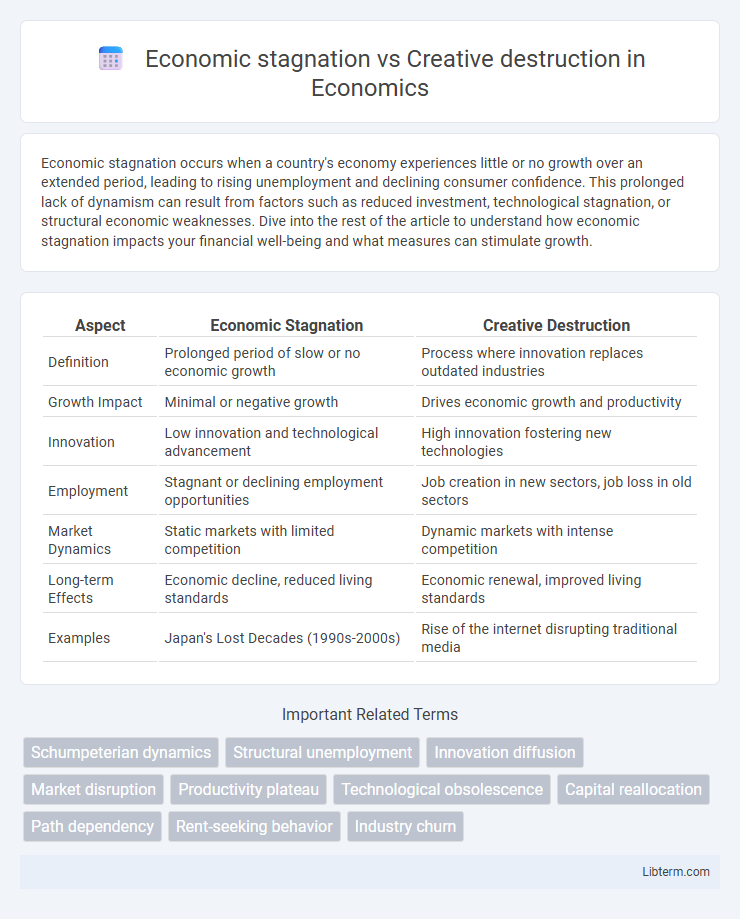Economic stagnation occurs when a country's economy experiences little or no growth over an extended period, leading to rising unemployment and declining consumer confidence. This prolonged lack of dynamism can result from factors such as reduced investment, technological stagnation, or structural economic weaknesses. Dive into the rest of the article to understand how economic stagnation impacts your financial well-being and what measures can stimulate growth.
Table of Comparison
| Aspect | Economic Stagnation | Creative Destruction |
|---|---|---|
| Definition | Prolonged period of slow or no economic growth | Process where innovation replaces outdated industries |
| Growth Impact | Minimal or negative growth | Drives economic growth and productivity |
| Innovation | Low innovation and technological advancement | High innovation fostering new technologies |
| Employment | Stagnant or declining employment opportunities | Job creation in new sectors, job loss in old sectors |
| Market Dynamics | Static markets with limited competition | Dynamic markets with intense competition |
| Long-term Effects | Economic decline, reduced living standards | Economic renewal, improved living standards |
| Examples | Japan's Lost Decades (1990s-2000s) | Rise of the internet disrupting traditional media |
Understanding Economic Stagnation: Causes and Consequences
Economic stagnation occurs when an economy experiences prolonged slow growth or no growth, often caused by factors such as declining productivity, reduced innovation, and insufficient investment in new technologies. This stagnation leads to higher unemployment rates, lower wages, and diminished living standards, creating a cycle of decreased consumer demand and further economic slowdown. In contrast, creative destruction drives economic dynamism by replacing outdated industries with innovative ones, fostering growth, technological advancement, and increased productivity.
Defining Creative Destruction in Modern Economies
Creative destruction in modern economies refers to the continuous process where outdated industries and technologies are dismantled and replaced by innovative products and business models, driving economic growth and productivity. This dynamic mechanism fosters competition, encourages entrepreneurship, and reallocates resources to more efficient uses, counteracting economic stagnation. Unlike economic stagnation, which is characterized by prolonged slow growth and diminished innovation, creative destruction fuels structural transformation and long-term economic resilience.
The Historical Context: Stagnant Periods vs. Innovative Surges
Economic stagnation often occurs during prolonged periods where innovation slows and productivity growth remains flat, as seen in the Great Depression and Japan's Lost Decade. In contrast, phases of creative destruction, exemplified by the Industrial Revolution and the rise of digital technology in the late 20th century, drive rapid technological advances and market transformations. Historical patterns reveal that innovative surges disrupt stagnant economies by replacing outdated industries with new, growth-oriented sectors.
Key Indicators of Economic Stagnation
Key indicators of economic stagnation include prolonged low GDP growth, persistently high unemployment rates, declining productivity, and reduced levels of investment in innovation and capital goods. Inflation rates may remain stable or low, but stagnant wages and weak consumer demand signal underlying economic weakness. In contrast to creative destruction, which fosters dynamic industry shifts and technological advancement, economic stagnation reflects a lack of renewal and diminished economic vitality.
The Role of Creative Destruction in Economic Revitalization
Creative destruction acts as a catalyst for economic revitalization by dismantling outdated industries and enabling the emergence of innovative technologies and business models. This process reallocates resources toward more productive sectors, fostering increased efficiency and long-term growth. Economies resistant to creative destruction often face prolonged stagnation due to rigid structures and lack of adaptive mechanisms.
Policy Responses: Stimulating Innovation or Preserving Stability?
Policy responses to economic stagnation often emphasize stimulating innovation through increased investment in research and development, tax incentives for startups, and fostering competitive markets to drive creative destruction. Conversely, preserving stability may involve regulatory measures, social safety nets, and protecting incumbent industries to prevent market disruptions and social unrest. Balancing these approaches requires targeted strategies that promote dynamic entrepreneurship while maintaining economic resilience and social cohesion.
Impact on Labor Markets: Job Losses and Job Creation
Economic stagnation often leads to prolonged job losses due to reduced business investments and slower innovation cycles, causing unemployment rates to rise and labor markets to contract. In contrast, creative destruction drives dynamic job creation by enabling new industries and technologies to emerge, even though it temporarily displaces workers in obsolete sectors. This continuous process reshapes labor markets by reallocating human capital from declining industries to more productive and innovative ones, fostering long-term employment growth and economic vitality.
Case Studies: Nations that Embraced Creative Destruction
Nations like South Korea and Singapore exemplify the benefits of embracing creative destruction by continuously fostering innovation and reallocating resources toward emerging industries, leading to sustained economic growth. These countries replaced outdated sectors with advanced technology and services, spurring productivity and global competitiveness. Contrastingly, economies resistant to structural change often face prolonged stagnation due to inefficiencies and lack of adaptability in global markets.
Risks and Downsides: Navigating Disruption and Inequality
Economic stagnation leads to prolonged periods of low growth, rising unemployment, and decreased innovation, resulting in reduced living standards and increased social discontent. Creative destruction, while driving innovation and long-term economic dynamism, can cause short-term job losses, industry decline, and exacerbated income inequality as workers and regions struggle to adapt. Managing these risks involves comprehensive policies that support workforce retraining, social safety nets, and equitable access to new economic opportunities.
Future Outlook: Balancing Sustainable Growth with Innovation
Economic stagnation threatens long-term prosperity by limiting growth and job creation, while creative destruction drives innovation and market revitalization through the replacement of outdated industries. The future outlook hinges on balancing sustainable growth with disruptive innovation, fostering ecosystems where emerging technologies and traditional sectors coexist and evolve. Policymakers and businesses must prioritize investments in research, education, and infrastructure to support dynamic economic transformation without exacerbating social inequalities.
Economic stagnation Infographic

 libterm.com
libterm.com